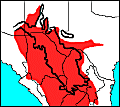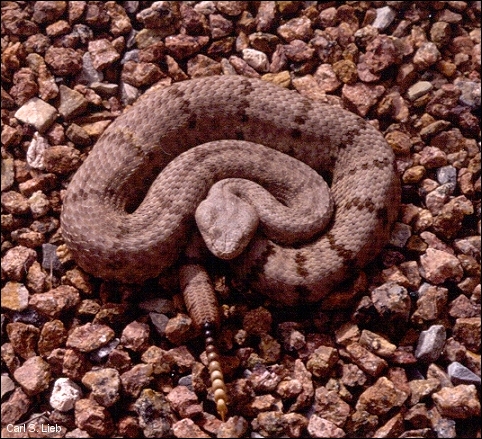


Crotalus lepidus. Photographer: Dr. Carl S. Lieb. Indio Mountains Research Station, Hudspeth Co., TX.
Adult length is 15-33 in (38-83 cm). Back with narrow dark crossbands on a lighter ground color. The crossbands may be black, dark brown, or dark gray. The ground color tends to match the color of the terrain of which it inhibits, and thus may be pale gray, bluish gray, greenish gray, tan, or pinkish. The upper preocular is split vertically and the scales are keeled in 23 rows.
Southeastern Arizona to western Texas, south to Jalisco, Mexico. Can be found from about 1000 ft. above sea level to around 9600 ft. (300-2930 m).
Crotalus lepidus is known to inhabit mountain and hilly terrain with rocky ridges, rockslides, outcrops, and stream beds. Its range extends from arid and semiarid desert grassland habitats up through to the lower edge of ponderosa pine forest.
The Rock Rattlesnake feeds mostly on lizards, snakes, frogs, and small mammals.
Live bearing. Birth usually occurs from July through August with a brood size that varies from 2-8. Young measure about 6.75-8 in (17-20 cm) long and are similar to adults in coloration.
In the dry areas of West Texas, this species is often observed or collected in the area of intermittent streams along banks or cliff bottoms. An unusual characteristic about this rattlesnake is that often times it will not rattle when closely confronted by humans.
Kinniburgh, R. M. 1972. Distribution of Thermal Responses of the Rattlesnake (Genus Crotalus) in El Paso County, Texas. University of Texas at El Paso.
Klauber, L. M. 1982. Rattlesnakes. University of California Press, Berkeley.
Stebbins, R. C. 1985. A Field Guide to Western Reptiles and Amphibians. Houghton Mifflin Company, Boston.
Tennant, A. 1985. A Field Guide to Texas Snakes. Texas Monthly Press, Hong Kong.
William D. Beltran, July 1997.
Last Update: 11 Jul 2009